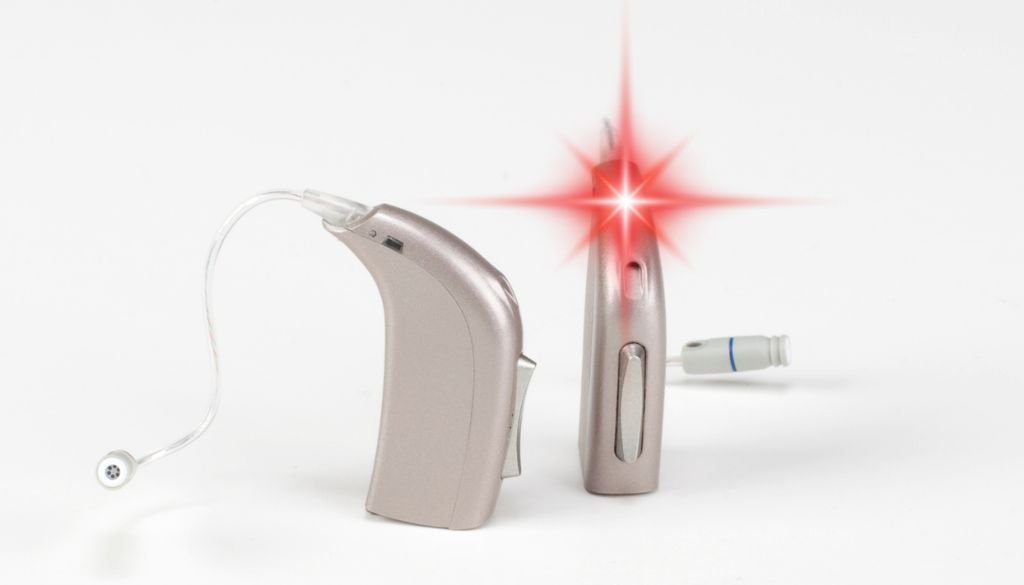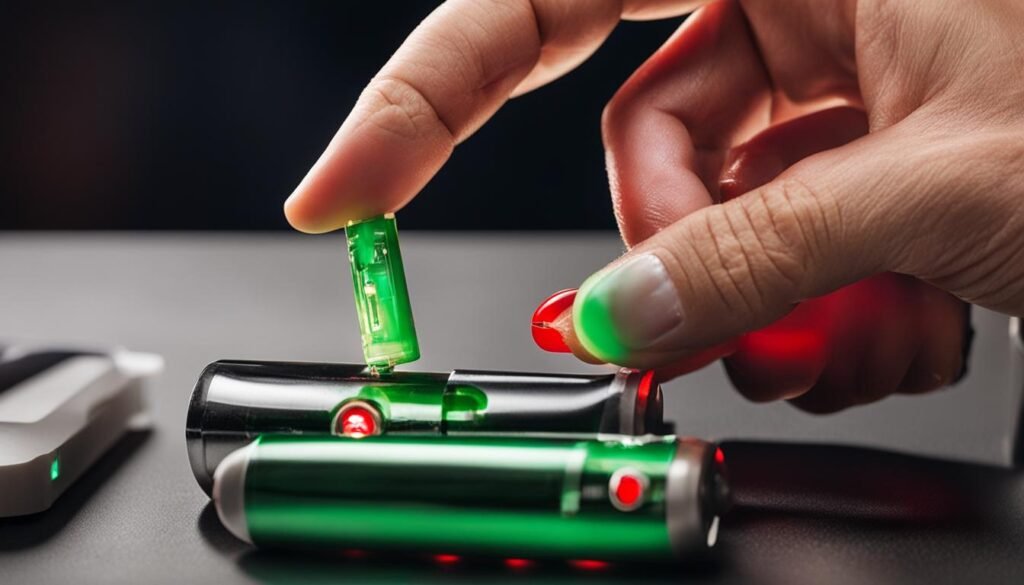“Why is my hearing aid flashing red?” If you’ve noticed this in your hearing aid, it’s crucial to understand the underlying reasons and take the appropriate steps to resolve the issue. The flashing red light is a warning sign indicating a problem that needs immediate attention, as it may affect the functionality of your device.
There are several common reasons why your hearing aid may be flashing red. Factors like exposure to dirt, moisture, and earwax buildup can interfere with the device’s operation. Regular maintenance is critical to preventing these issues; however, additional troubleshooting or professional servicing is sometimes necessary to fix the problem.

To begin troubleshooting on your own, check your hearing aid’s battery. A flashing red light often indicates a depleted battery. If the battery is low, replacing it with a new one is a simple solution. Additionally, a buildup of earwax can also cause the device to malfunction. Cleaning the tubing and checking for any obstructions or coverage triggering the flashing red light is a good practice.
For those with rechargeable hearing aids, specific troubleshooting steps, such as checking the temperature range or performing a reset, may be required. It is always advisable to consult the manufacturer’s instructions for guidance tailored to your device.
While these DIY tips can be practical for fundamental issues, a professional should address persistent problems. Consulting a hearing aid specialist or audiologist is crucial for diagnosing and repairing the underlying cause of the flashing red light.
Key Takeaways:
- A flashing red light on your hearing aid indicates an issue that requires attention.
- Common reasons for the flashing red light include dirt, moisture, earwax buildup, and low battery.
- Basic troubleshooting steps include checking the battery, removing excess earwax, and inspecting for obstructions.
- Rechargeable hearing aids may have specific troubleshooting steps, such as checking the temperature range or performing a reset.
- If problems persist, it’s best to seek professional help from a hearing aid specialist or audiologist.
How to Troubleshoot Hearing Aid Problems
If you’re encountering issues with your hearing aid, it’s essential to troubleshoot the problem to ensure optimal performance. Here are some standard troubleshooting steps you can take:
- Check the battery: A low or dead battery could be the culprit if your hearing aid is not working. Replace the battery with a new one and ensure it is properly inserted.
- Clean the earmold or wax guard: If you’re experiencing whistling or feedback, it could be due to a blockage. Remove the hearing aid and clean the earmold or replace the wax guard if necessary.
- Reinsert the hearing aids: Whistling or feedback can also occur if the hearing aids are not inserted correctly. Ensure they are securely in place, and adjust the volume if needed.
- Address weak or distorted sound: If you’re hearing weak or distorted sound, it could indicate a battery issue, dirty contacts, or wax buildup. Check the battery level, clean the connections connections, and inspect the tubing for wax accumulation.
Additional Tips for Troubleshooting Hearing Aids
For rechargeable hearing aids, it’s essential to follow specific troubleshooting steps provided by the manufacturer. This may include checking the charger temperature, addressing system errors, or performing a reset. Watching how-to videos can also offer guidance on tasks such as changing domes, replacing wax guards, and cleaning the hearing aids.
“Taking proactive steps in troubleshooting your hearing aids can help resolve common issues and ensure optimal performance.”
If you’ve gone through the troubleshooting steps and the problem persists, it may be time to seek professional help. They have the expertise and tools to diagnose and repair more complex issues. Remember, maintaining your hearing aid through regular cleaning and maintenance is crucial for long-term performance.
Maximizing the Life of Your Hearing Aid Batteries
If you want to make your hearing aid batteries last longer, there are a few steps you can take. Firstly, ensure that your batteries are fully charged before use. This will help maximize their lifespan and avoid unexpected battery failures. For disposable batteries, replace them when they are dead or low on power. By doing so, you can ensure that your hearing aids are consistently powered and perform optimally.
Does prednisone help tinnitus? Delve into the specifics of ‘does prednisone help tinnitus’ in our in-depth article, where we analyze the effectiveness of this medication for tinnitus sufferers.
When your hearing aids are not in use, turning them off or opening the battery door is essential. This helps minimize battery drain and preserves the power when you genuinely need it. Keeping your hearing aids away from extreme temperatures can also help extend battery life. Excessive heat or cold can reduce battery performance and shorten their lifespan.
If you use rechargeable hearing aids, follow the manufacturer’s recommendations for changing the batteries. Typically, rechargeable batteries should be replaced every 6-12 months. It’s essential to adhere to this schedule to ensure the longevity of your hearing aids. To prolong the life of rechargeable batteries, charge them every night and ensure that the charger lights indicate active charging.
By maximizing the life of your hearing aid batteries, you can enjoy consistent and reliable performance from your hearing aids while avoiding unexpected battery failures.
Tips for Maximizing Hearing Aid Battery Life:
- Ensure batteries are fully charged before use.
- Replace disposable batteries when low on power.
- Turn off hearing aids or open the battery door when not in use.
- Avoid exposing hearing aids to extreme temperatures.
- Follow the manufacturer’s recommendations for changing rechargeable batteries.
- Charge rechargeable batteries every night
Common Reasons for Hearing Aid Breakdowns and Prevention
Hearing aids, like any electronic device, can experience breakdowns due to various factors. Understanding the common reasons behind these breakdowns and taking preventative measures can help ensure the longevity and optimal performance of your hearing aids.
Fixing Hearing Aid Problems at Home
- Wax Buildup: One common issue that can cause hearing aid breakdowns is wax buildup in the filters. This can block the sound transmission and affect the device’s overall performance. To fix this problem at home, you can clean or replace the filters if necessary. Regular maintenance and cleaning of the hearing aids can help prevent wax buildup.
- Moisture: Another common culprit for hearing aid breakdowns is moisture damage. Sweat, humidity, or extreme weather conditions can accumulate moisture in the device, causing corrosion and damage to the electronic components. Wiping the hearing aids regularly and using a dehumidifying box can help prevent moisture damage.
Addressing these common issues at home can resolve the breakdowns and keep your hearing aids functioning optimally. However, there are certain instances where there may be better courses of action than attempting to fix the problems at home.
“If you are unsure about how to fix a specific problem or if the breakdown persists despite your best efforts, it’s always advisable to seek professional help. A hearing aid clinic or audiologist has the expertise and tools to diagnose and repair more complex issues,” says Dr. Jane Anderson, an audiologist with over ten years of experience.
When Not to Wear Hearing Aids
While it’s essential to wear your hearing aids regularly to improve your hearing, there are certain situations where it’s best to avoid wearing them to prevent damage or breakdowns:
- In wet environments: Hearing aids are not designed to be worn in wet conditions like showering or swimming. Exposure to water can cause irreparable damage to the device.
- During intense physical activities: Activities that involve excessive sweating or vigorous movements can increase the risk of moisture damage or dislodging the hearing aids from your ears.
- When using hair care products: Certain hair care products, such as hairsprays or gels, can contain chemicals that may damage the hearing aids. It’s best to remove the devices before applying these products.
By understanding the common reasons for hearing aid breakdowns and taking preventative measures, you can ensure your devices’ longevity and optimal performance. However, if you encounter persistent problems or more advanced repairs are needed, seeking professional help from a hearing aid clinic or audiologist is recommended.
Seeking Professional Help for Hearing Aid Problems
Even with careful troubleshooting and maintenance, there may come a time when you need to seek professional help for your hearing aid problems. Don’t worry; there are experts available who can diagnose and repair more complex issues to get your hearing aids back in optimal working condition.
Learn the truth behind whether can anxiety cause hearing loss
If you have followed the troubleshooting tips and the problems with your hearing aids persist, it’s time to visit a hearing aid clinic or an audiologist. These professionals have the necessary tools, knowledge, and experience to assess and address the specific issues with your hearing aids.

When troubleshooting doesn’t work, it’s essential not to delay seeking professional help. Using malfunctioning hearing aids can lead to further damage and potentially costlier repairs. It’s better to address the issue promptly and ensure you can hear clearly and comfortably.
At a hearing aid clinic, you can expect a thorough examination of your hearing aids by experts specializing in diagnosing and repairing hearing aid problems. They will be able to identify any underlying issues and provide appropriate solutions. Additionally, they can offer services like cleaning and maintenance to optimize the performance and lifespan of your hearing aids.
When to Visit a Hearing Aid Clinic
- If you have tried, all the troubleshooting tips and your hearing aids are still not functioning properly.
- If you experience any sudden changes in sound quality or volume
- If you notice physical damage to your hearing aids
- If your hearing aids are still under warranty and require repair or replacement
What to Do if Troubleshooting Doesn’t Work
“If you have exhausted all troubleshooting options and your hearing aids are still not working correctly, it’s best to seek professional help. A hearing aid clinic or audiologist can provide the expertise and support needed to diagnose and repair your hearing aids. Don’t hesitate to reach out to them for assistance.”
Conclusion
Properly caring for your hearing aids and performing regular maintenance is crucial for optimal performance. By following the troubleshooting steps outlined in section 2 and maximizing the life of your hearing aid batteries, as suggested in section 3, you can address common issues and extend the lifespan of your devices.
Preventing common problems such as wax buildup and moisture damage, as discussed in section 4, is essential in preserving the functionality of your hearing aids. Avoid wearing them in wet environments like the shower or swimming.
If you’ve tried troubleshooting and the issues persist, section 5 recommends seeking professional help. Audiologists at hearing aid clinics have the expertise to diagnose and repair complex problems, ensuring your hearing aids are in optimal condition.
By taking proactive steps in hearing aid care and maintenance, you can enjoy improved hearing and maintain the longevity of your devices, optimizing your overall hearing aid performance.
Frequently Asked Questions
Why is my hearing aid flashing red?
The flashing red light on your hearing aid indicates an issue that requires attention. It could be due to problems like low battery, excess earwax buildup, or a need for professional servicing. Troubleshooting is recommended, but if the problem persists, it’s best to contact a professional.
How do I troubleshoot hearing aid problems?
Troubleshooting hearing aid problems involves various steps based on the issue. If there is no sound, check the battery, replace it if necessary, and clean the earmold or wax guard. Whistling or feedback can be resolved by reinserting the hearing aids, adjusting the volume, and ensuring no obstructions. Weak or distorted sound may indicate a dead or weak battery, dirty contacts, or wax buildup in the tubing. Troubleshooting steps for rechargeable hearing aids may include checking the charger temperature, addressing system errors, or resetting the hearing aids. Watching how-to videos can also guide changing domes, wax guards, and cleaning the hearing aids.
How can I make my hearing aid batteries last longer?
To extend the life of your hearing aid batteries:
- Ensure they are fully charged before use.
- For disposable batteries, replace them when they are dead or low on power.
- When the hearing aids are not in use, turn them off or open the battery door to minimize drain.
Rechargeable batteries should be charged every night, ensuring the charger lights indicate active charging. Following the manufacturer’s recommendations for replacing rechargeable batteries is essential, typically every 6-12 months. Taking proper care of the batteries and following charging guidelines can help maximize their lifespan.
What are common reasons for hearing aid breakdowns, and how can I prevent them?
Hearing aids may experience breakdowns due to various reasons. Common issues include battery depletion, filter wax buildup, and moisture damage. Replacing the battery and cleaning the filter are simple troubleshooting steps you can do at home. Wax buildup can block sound transmission, requiring filter replacement. Moisture, such as sweat, can corrode the battery area and affect the electronic components. Using a dehumidifying box or wiping the aid down can help prevent moisture damage. Additionally, it’s essential to avoid wearing hearing aids in wet environments like showers or swimming.
When should I seek professional help for hearing aid problems?
While troubleshooting can often resolve fundamental hearing aid problems, some may require professional help. If the troubleshooting tips don’t fix the problem, visiting a hearing aid clinic or audiologist is advisable. They have the necessary tools and expertise to diagnose and repair complex issues. Hearing aid clinics can also provide services like cleaning and maintenance to ensure optimal performance. If your hearing aids are still under warranty, contacting the manufacturer or authorized dealer for repair or replacement options is essential.
How can I care for my hearing aids to maintain their optimal performance?
Taking care of your hearing aids and performing regular maintenance can help ensure their optimal performance. Following troubleshooting steps, maximizing battery life, and preventing common issues like wax buildup and moisture damage are essential for maintaining the longevity of your hearing aids. However, if problems persist or more advanced repairs are needed, seeking professional help is recommended. By taking proactive steps in caring for your hearing aids, you can enjoy improved hearing and enhanced overall hearing aid performance.



